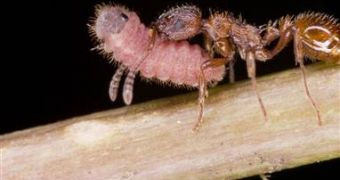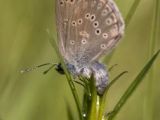Ants are really vicious. They bite, sting and splash with formic acid, which is quite toxic. Yet the colony fed by thousands of hard-working laborers represents an irresistible target for parasites. A new Danish research published in the Science journal and carried on the Myrmica rubra ant species has revealed cases when the tiny workers counteract, boosting a co-evolutionary arms race involving more closely related species.
The Myrmica rubra is parasited by the Alcon blue butterflies, which lay their eggs on marsh gentian plants located close to ant colonies. The hatching caterpillars have an outer layer spreading the same hydrocarbon molecules as the ants' cuticles.
Ants rely heavily on these pheromones in their social interaction and the strategy fools foraging ant workers, which take the caterpillars for ant larvae (these caterpillars not even resemble a classical one but rather an ant larva) and transport them into their nests, where they are nurtured using food that could have produced new ants.
The team lead by David R. Nash of the University of Copenhagen discovered that the ants' genes producing these pheromones may differ from population to population, and the infected colonies revealed the highest variance between populations.
Those butterflies carrying the best genes fitting to a colony's unique signature delivered the most caterpillars fed by ants. It appeared that the ants change continuously their cuticle pheromones avoiding the parasite caterpillars, but, at the same time, the butterflies react through a more complex chemical combination.
The team also found that Myrmica ruginodis ants, also parasited by the Alcon blue butterflies, don't have the same genetic variance between populations.
"Alternative hosts may therefore provide an evolutionary refuge for a parasite during periods of counteradaptation by their preferred hosts," wrote the authors.
In various location in Europe, the Alcon butterfly has a different ant species host.
Other caterpillars can have an extremely different relation with the ants (besides most caterpillars being ant prey). Caterpillars of some Lycaenidae butterflies exude sweet secretions, and are farmed by the ants, just like aphids.

 14 DAY TRIAL //
14 DAY TRIAL // 
